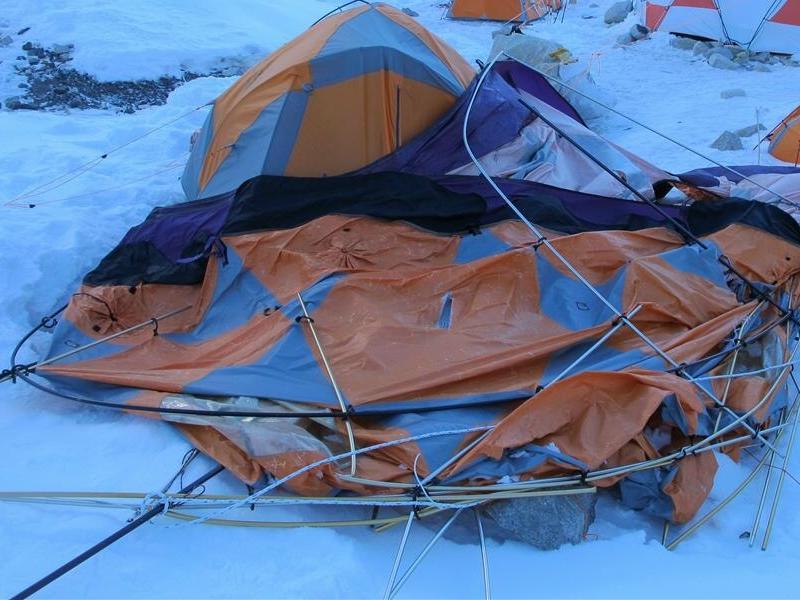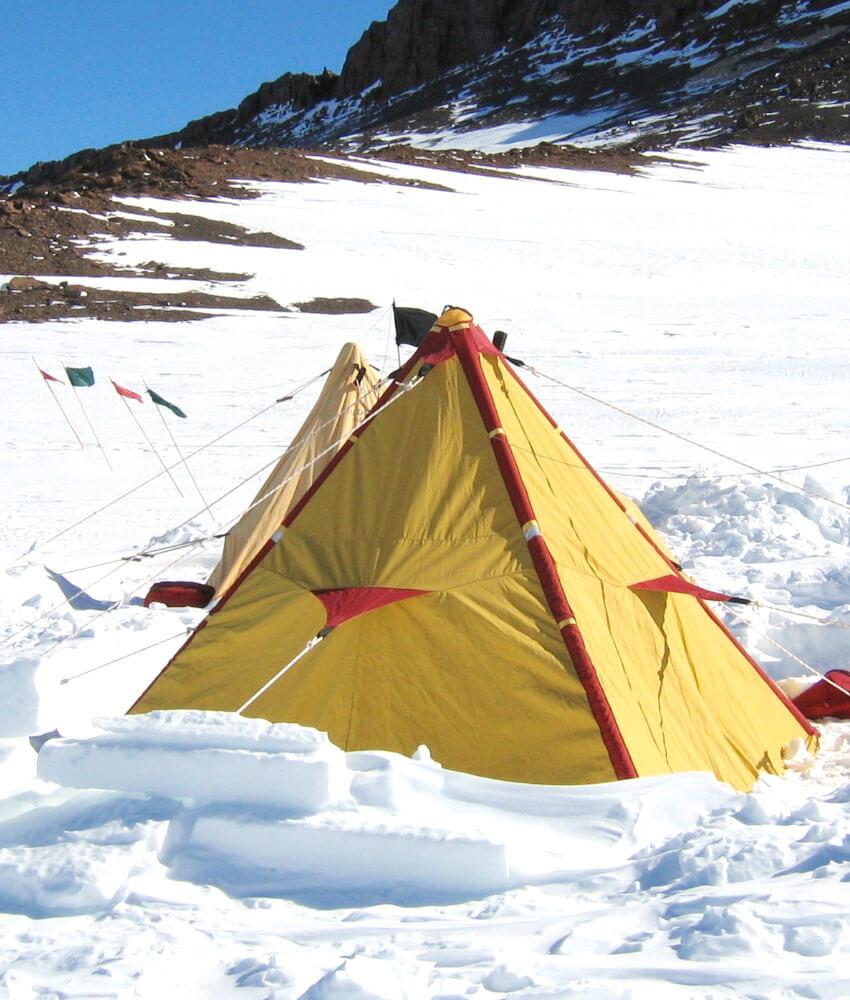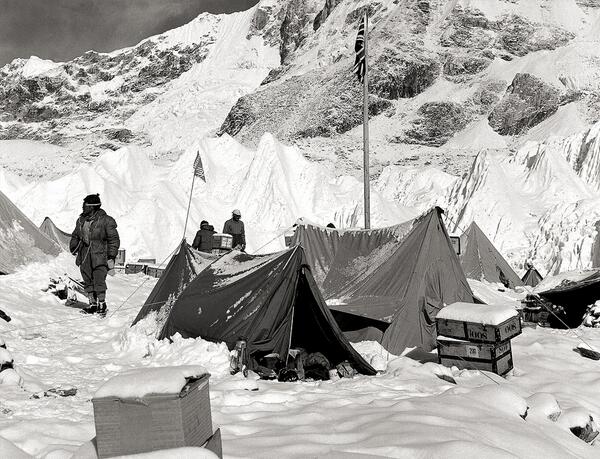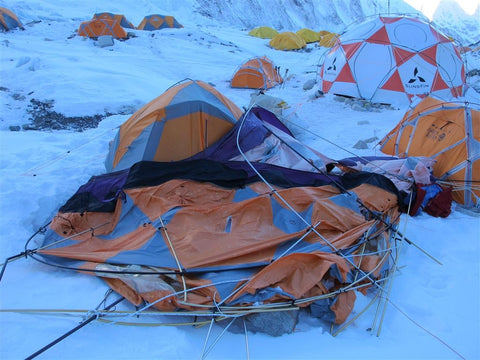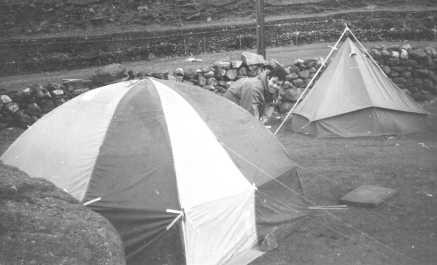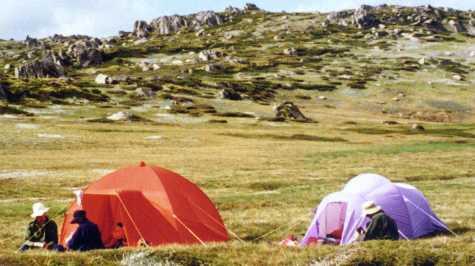Topic
why tents fail in the wind
Forum Posting
A Membership is required to post in the forums. Login or become a member to post in the member forums!
Home › Forums › Gear Forums › Gear (General) › why tents fail in the wind
- This topic has 172 replies, 33 voices, and was last updated 4 years, 11 months ago by
 Roger Caffin.
Roger Caffin.
-
AuthorPosts
-
Mar 9, 2020 at 11:43 pm #3635088
That has got to be one of the more useless quotations I have heard recently.
For a start, what sort of tent are they talking about? It does matter, you know.By way of example: the side guys on my tunnels are expressly designed to go down to the ground at about 45 degrees as they are normally seen in my photos. Run them up over a trekking pole and you would be lifting the tent up – in a storm. Idiotic idea! A downwards guy rope pulls the tent down, onto the ground, which is where you want it in bad weather.
Maybe the middles of some pop-ups need to be held up, so they don’t flatten out on the ground. I can see that for sure, but trying to use a pop-up on a ridge in a mountain storm is not really the act of an intelligent walker.
As for the tests run on peg angle by the designers – where do you find compacted mountain soil and grass in a wind tunnel? Bah!
Cheers
Mar 9, 2020 at 11:44 pm #3635089Geoff, Re:
“Except that all the major shelter failures I’ve actually seen in the field have been caused by breakage of bendy poles.”
“While 7075 T6 aluminium trekking poles are going to take anything that nature can throw at you, …”
Note that T6 refers to temper. That is a soft temper, and will bend easily with a good tube bender like a Ridgid. Easton is up to T9 these days for alloy tent poles. But I am using multi-layered carbon fiber poles that my break tests showed had about the same strength as the heavier Easton .344 tent poles, sometimes referred to as ‘nanolites.’ Both were stronger than any of the many other carbon poles I tested; but note that Quest recently began selling a heavier Easton carbon tent pole, about 33% heavier than mine, but probably stronger. Have not tested it because feel secure with the poles I have.
I’ve not seen a breakage of an Easton T9 in use, though with enough force, anything will break. But have seen on BPL a video of a Warmlite pole bending out of shape. Warmlite used an even lower temper than T6 at the time anyway, so no surprise there. Bought a few to use as shims (adaptors) to join different size tubing on pack frames. They’re good for that at least.
I’d like to know more about the “major shelter failures” you’ve seen with “bendy poles.” That would help provide a better understanding.
Ryan titled the thread, “Why tents fail in the wind.” He didn’t say “trekking pole tents,” just tents. But I understand what you and many are saying; namely, that “with a properly executed trekking pole shelter the only significant point of failure is pegging.” If “properly executed,” means properly designed, then would agree of course; just as I would agree that on Roger’s tunnels the side-guy stakes are critical because the sides of the tunnel are the closest to vertical walls on the tunnel. No surprises there, I hope.
However, don’t think many understand me about the considerable reduction of stress on stakes in a properly designed framework tent, where the stakes are there primarily to anchor the tent; but not primarily to support it, as is the case with a trekking pole tent. The lack of understanding may be due to a failure to communicate on my part, as Paul Newman said; so am not going to stop being a voice crying in the wilderness when there are better tents to be had. Maybe I’ll get it right eventually.
Just a thought though; why do so many films of treks in the highest mountains show climbers using tents with ‘bendy poles.’ Can’t recall one with an A-frame, two poles and lots of guys and stakes. The photo of the Akto posted by Nick has lots of guys and stakes; but then again, the Akto is supported by a ‘bendy’ pole also.
Mar 10, 2020 at 12:52 am #3635092“why do so many films of treks in the highest mountains show climbers using tents with ‘bendy poles.’”
And many of those tents are freestanding (or nearly so) and fairly rigid geodesic domes, such as the several-decades-old North Face VE-25 design:

Stakes keep these designs from blowing away and provide extra tension in very high winds.
Not exactly light weight at 10.3 lbs / 4.7 kg for the VE-25. Tradeoffs!
— Rex
Mar 10, 2020 at 3:29 am #3635095Yeah, those multi-poles geodesics are not bad. They do have their limits though.

If I remember correctly, this was, once, a geodesic.
Cheers
Mar 10, 2020 at 3:43 am #3635096Rex,
Nothing wrong with a pyramid design either .
That is if you put up with a 70LBS tents that has 4 x 1″ poles to house 2 . Mar 10, 2020 at 3:50 am #3635097
Mar 10, 2020 at 3:50 am #3635097That looks rather like an Australian One Planet tent, made in Melbourne for the Australian National Antarctic Research Expedition (ANARE). The owner of One Planet is an acquaintance of mine from long ago.
Good tent, with 100 mm (4″) aluminium poles and 6 mm (1/4″) guy ropes.
Cheers
Mar 10, 2020 at 4:44 am #3635100Until the mid ’70s pretty pretty much all high altitude tents were A frames, mixed in with the occasional polar-style mids.

Here’s the classic Gerry tent the Americans were using from the ’50s to the ’70s:
In the UK Doug Scott, for example, was in the high ranges a couple of dozen times with the Vango Force 10 – a tent I used a lot.
The difference is that the old-style mountain tents used heavy cotton fabrics which are much stiffer than modern 20D nylons and polys, so required less guying of the side-walls to keep them quiet and stable. Plus they used heavy A-frame poles and often an equally heavy ridge-pole.
From memory, I think the classic Force Ten weighed in at around 5.5kg – they sure made a man of you! But they were rock solid in any kind of weather with just 2 side-wall guys and 8 pegs around the fly, and many are still functional 50 years on.

Mountaineers rarely use trekking poles, so they are hardly going to be using trekking pole designs. If you are carrying separate poles a good geo design is going to be more liveable for multiple occupancy compared weight-for-weight with an A-frame of similar strength, and a near freestanding shelter is a big plus on tight alpine pitches. So that’s what is used nowadays.
But you ain’t going to be carrying either for lightweight hiking so it’s a bit of an academic issue. A modern Dyneema trekking pole shelter is approaching 1/10th the weight of the Force 10 so it’s a different ball-game.
Yes – trekking poles generally use the T6 temper. T9 is stronger but more brittle. As we can see from the frequent breakages of strong but brittle carbon trekking poles, the more resilient T6 temper is ideal for the forces on a trekking pole and is still plenty strong enough to be a bomber shelter support. Bendy tent poles require different properties which is why the T9 is used on high end products.
Obviously, the simplest bendy pole design is the Atko-style single hoop. But this seems to require a certain amount of weight to work. A well pitched Atko, at 1.5kg, can take almost anything, while the very similar Enan, at 1.2kg, is only recommended for sheltered sites. Go even lighter and the Terra Nova Laser Competition, at 1kg, has a bad reputation for breaking its pole. I guess it comes down to detailed issues of design and materials. If you want a 3.5 season shelter for under 1.5kg, you’re going to be using a trekking pole design, I think.
My main point is that aluminium trekking poles are never going to fail as a shelter support, and nor is the fabric on any decently built shelter provided you don’t go to extremes with fabric weight. So it’s the staking that’s the crucial issue for trekking pole designs.
For sure a bendy pole geo can reduce strain on the pegging points, but the weight penalty is going to be prohibitive for most people here. So if we want to handle big winds for under 1kg we need wind-shedding panels with trekking pole support, an adequate number of guying points, and pegs with holding power placed with good technique.
What’s been interesting about this discussion is that designing and placing a lightweight peg for holding power is more of an open issue than I thought. Let’s get experimenting and reporting our results!
Mar 10, 2020 at 5:00 am #3635101Just as a point of interest, I believe Easton is the only company in the world which can make 7075 alloy at a T9 temper. Normally, the Tempering scales only go up to T6 anyhow. I don’t think there is a huge amount of published techie info on how they do it. It is rather interesting stuff.
The 7075 T9 alloy is the mainstay for Easton. They did experiment with a slightly stronger 7078 (T9?) alloy for a while, but it proved to be too brittle, with failures in the field. As I found out to my embarrassment.
Cheers
Mar 10, 2020 at 5:00 am #3635102It isn’t just pegs failing tho.
Ultra lite tents are it seems built like Super Maxi racing yachts, everything is pared down to the limit and there is no “spare” strength. While modern fabrics are small engineering and chemical miracles I guess the simple fact is that is the UL tents are simply weaker than heavy weight tents
Mar 10, 2020 at 5:14 am #3635104I did see a report on Trek-Lite of a Z-Packs Duplex (A tent I don’t consider a bomber weather shelter) having a corner tear off in 60mph winds, but I agree most failures are not fabric failures or even pole failures, but staking issues.
Mar 10, 2020 at 5:14 am #3635105Ah yes, designing tent pegs. Great fun, but very dependent on what you stick the pegs into.
For 3-season use in any of the mountains we have walked in, I find a set of Ti wires for the guy ropes plus 4 tube pegs for the corners (2 each end of a tunnel) is sufficient, at 82 g for the lot. They have taken ‘some weather’.
However, for snow use one needs a bit more area. Since aluminium sticks to ice rather well, making it sometimes almost impossible to get the pegs out in the morning, I have resorted to using sheet titanium. My MYOG adventures there are described in
https://backpackinglight.com/make_your_own_gear_titanium_snow_stakes/
https://backpackinglight.com/myog_ti_snow_stakes_part_2/There were some traps for the unwary in using Ti: it is hard enough to fray and break Spectra if you don’t buffer the holes or edges. A full set of snow pegs for my winter 4-pole tunnel weighs a lot more: about 400 g. But the full set will hold against 100 kph winds over night.

The big deadman anchors are for the corners; the angles are for the guys. Possibly overkill for many more sheltered situations.
Cheers
Mar 10, 2020 at 6:39 am #3635110There are at least three different types of staking points on most tents: floor, fabric to guy line, and pole to guy line.
All floor stakes should be about a 45 degree angle with no elasticity. Like a sheet of paper on the ground, it tends to stay put under high winds. Even with light staking power a floor will tend to stay put. It will have good wind resistance pretty much independently of the rest of a tent body.
Fabric to guy line should incorporate an elastic of some sort to lengthen the impact moment. Flapping and other forces contributing to Wind hammer can occur easily with wider panels.
Pole to guy line staking wants less elasticity. These normally mount firmly to the ground, and, the highest point on a shelter. A longer line forming about a 30-35* angle to the ground with some elasticity is wanted, here.
Assuming an open campsite, the general wind velocity above the ground-effect layer is important for tent and stake stability. Taller tents will often put much higher wind forces on a stake.One, two and three guy lines can be used to on these.
Dynamic forces should be allowed for also. Gusts provide some wind hammer, but the main component seems to be from flapping and ripples created in the fabric. This often results in forces MUCH higher than measured at steady state. These types of force peaks do the most damage to stake points.
Many other factors can influence stake holding: soil type, lubrication, root mass, etc.
Mar 10, 2020 at 7:00 am #3635113Roger, re:
“If I remember correctly, this was, once, a geodesic.”
Hmm. Wonder why the tent behind it is still standing.
“A full set of snow pegs for my winter 4-pole tunnel weighs a lot more: about 400 g.”
Yes, that is about what I figured, a bit less than a pound.
Mar 10, 2020 at 7:10 am #3635117Geoff, re:
“For sure a bendy pole geo can reduce strain on the pegging points, but the weight penalty is going to be prohibitive for most people here.”
About how heavy in your view would that prohibitive weight penalty be?
Mar 10, 2020 at 11:35 am #3635143Roger, you left out the best part – that big dome that *didn’t* blow down!
They’ve got some good content for gear geeks: fabric coatings, internal guy lines, adding trekking poles to freestanding tents and their web truss concept, among others. Also, check out their crazy hard shell pack.
https://www.slingfin.com/blogs/the-beta
Mar 10, 2020 at 4:16 pm #3635169Yeah, but HEAVY!
Also, they are still promoting (or blindly following) the need for toxic and ineffectual Fire Retardants in their coatings. These chemicals are steadily being banned around the world on health grounds. Since they don’t work at all at the concentrations used, they are also pointless.
Cheers
Mar 10, 2020 at 6:06 pm #3635187Nothing that sleeps 12 above 20,000′ is particularly light.
40 lbs / 12 people = 3.33 lbs/person. Typical for commercial expedition tents. About the same as the VE 25 and Atko, better than most 2-person, and blows away the old A-frames.
Don’t see the relevance of fire retardant, but see the 2nd to last paragraph here. A handful of US states (including California) still require it, so compatibility of retardant with various waterproof coatings counts as a feature. They indicate a mild aversion to it, but don’t make a point of expressing an opinion either way.
And yes, I’m aware your winter tent is half that weight per person. Maybe you should try your hand at something with a 2m radius :)
My point in posting is that a free standing, bendy pole dome *can* withstand a once in a decade (or more?) storm on Everest, and that SlingFin have some proven ideas worth reading about. I think their truss is brilliant.
Mar 10, 2020 at 7:02 pm #3635194Maybe you should try your hand at something with a 2m radius :)
Been there, done that. The two-colour (blue & yellow) dome in the foreground (nylon and good fibreglass poles) is from the 70s. It took some bad weather in SW Tasmania. It had internal strengthening guys likely before the founders of SlingFin were born.

A second generation of this dome is shown here on the left. I made it when the yellow nylon went paper-fragile and ripped. Too much UV exposure caused that. By that stage we had ‘graduated’ to a Macpac Olympus, on the right.

Both dome tents suffered from internal condensation under some conditions which showered down on sleeping bags and gear. Both tents were quite difficult to erect in bad weather: I had to peg out the corners and get inside to insert the poles. I was told the efforts looked amusing from the outside.
Cheers
Mar 10, 2020 at 7:04 pm #3635197I usually only bring about 4 pegs to get my mid up quickly, then add lots of big anchors-rocks, logs, ice axes, skis, snow deadmen etc. High winds above treeline in wintery eastern Oregon taught me not to trust single pegs alone, even in VE 24’s etc.
If you are going to use tent pegs primarily, check out these vids on pickets for vertical rescue.Notice they don’t use a V, they are placed in line, like good rock climbing bolt belays should be. Then use the stakes in back to tension the top of the stakes in front. These pickets are holding over 6000 lbs.
———
15 degree angle pickets with plates https://youtu.be/pPOYzc8418
———
pickets with webbing traditional 1 to1 to1 https://www.youtube.com/watch?v=Y0uIPR4Bzjs
Testing it. https://www.youtube.com/watch?v=b34Im0qlXOQ
Mar 10, 2020 at 7:15 pm #3635202Excuse me: 2.5m
Something the size of the dome I posted; sleeps 12.
Mar 10, 2020 at 7:22 pm #3635205My domes were 7′ (2.13 m) square, to sleep 4. The weight was not bad.
We did have 6 in it for a party (in bad weather) once.Cheers
Mar 11, 2020 at 3:41 am #3635235The Delta peg folks got back to me with a nice note, but they’re not interested in developing a product for the lightweight market.
But it does seem like an interesting concept. I’ll try and get a prototype together and report back if there’s anything of interest.
One thing that emerged from this thread is that I shouldn’t be assuming that 45 degrees is the most effective angle – I’ll try more vertical angles as well.
Mar 11, 2020 at 6:02 am #3635238I think you may be overlooking the real dynamic difference between the red and blue lines. The red line was ‘rattling’ around, and that is more of a problem.
I’m not missing that at all. Quite the contrary in fact, I said “I’m not suggesting that shelters should be set up floppy.”
I am saying that it’s dangerous to use a too-narrow focus to look at one part of a very complex problem. I have no doubt that stake failure (which is only one way that tents can fail) is dependent on both total force and the amount of load cycling.
Mar 11, 2020 at 3:02 pm #3635303“Complex” – I agree.
Despite all the storms we have lived through, I have never actually had a stake failure. Paranoia during pitching?Cheers
Mar 11, 2020 at 4:29 pm #3635308Kind of related to Sam F’s earlier comments on tent structure and its relation to stake holding power, and also tents for the high mountains: If you look at photos, you’ll find that tents used in the two most brutal environments – the poles and extreme high altitudes – show an interesting dichotomy. Polar explorers seem on average to prefer tunnels; mountaineers go mostly for domes. Conditions as to weather – pretty similar. But conditions as to campsite selection – quite different. Polar explorers have huge expanses of flat snow and ice. Plenty of room for all the pegs one would ever want to deploy. Mountaineers rarely have a flat spot, and may have to hack a platform out of the snowy side of a mountain. Tough to use guylines on the downhill side with the slope dropping off at a steep angle; tough to use guylines on the high side when that is a vertical wall of rock, or of neve you’ve just dug down into. So, the polar folks go for tunnels more often, which must be staked just to stay up, but with plenty of stakes and properly oriented will handle tremendous winds; while mountaineers tend to go for geodesics which rely on more pole structure for strength, but with only few stakes can still handle serious winds. Put it this way – if you can only put in 4 stakes, you are probably better off in a geodesic; but if you have room to run all the guylines you want, then a tunnel and plenty of stakes and line is lighter than the geodesic.
Tents work primarily by way of tensioning the fabric. In a trekking pole supported tent, or any pyramid style backpacking tent, it is all about the stake holding power, since the pole is the only thing in compression and it cannot tension the fabric at all without the tent being staked out. On a tunnel , the fabric can be tensioned in one direction by the poles (which again, are in compression), but only one. Stakes are required to get tension in the other direction. A geodesic frame can tension the fabric in both directions – which is why it can stand up without stakes if you have no wind and can handle light winds just by having you and your gear inside it. So the stakes don’t start out with a significant static load just to hold the thing up, and not all of the dynamic loads from winds are transferred directly to the anchors – some of that is handled by the pole structure. Thus, in terms of stake loading under a given set of conditions – and assuming optimal setup for each type of shelter – the geodesic requires less total anchor strength to keep it up and functional than does a tunnel, and the tunnel less than the pyramid/trekking pole type.
I leave the polar pyramid tents out of this. Those are completely different beasts, as they have a large diameter aluminum pole down each ridgeline. Lovely when weight is not an issue.
For most backpacking this is somewhat academic – but for some conditions, it’s worth considering. if you know the ground is going to be troublesome for staking, then a tent that relies less on it stakes may be worth some extra weight.
-
AuthorPosts
- You must be logged in to reply to this topic.
Forum Posting
A Membership is required to post in the forums. Login or become a member to post in the member forums!
Trail Days Online! 2025 is this week:
Thursday, February 27 through Saturday, March 1 - Registration is Free.
Our Community Posts are Moderated
Backpacking Light community posts are moderated and here to foster helpful and positive discussions about lightweight backpacking. Please be mindful of our values and boundaries and review our Community Guidelines prior to posting.
Get the Newsletter
Gear Research & Discovery Tools
- Browse our curated Gear Shop
- See the latest Gear Deals and Sales
- Our Recommendations
- Search for Gear on Sale with the Gear Finder
- Used Gear Swap
- Member Gear Reviews and BPL Gear Review Articles
- Browse by Gear Type or Brand.


